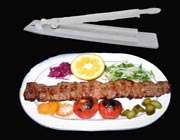KAB?B
popular dish which traditionally consists of meat cut in cubes, or ground and shaped into balls; these are threaded onto a skewer and broiled over a brazier of charcoal embers.
KAB?B (kebab, kabob, cabob), a popular dish which traditionally consists of meat cut in cubes, or ground and shaped into balls; these are threaded onto a skewer and broiled over a brazier of charcoal embers. After the kab?b is cooked, it is placed on a platter or tray and pulled off the skewer with a piece of flat bread. Because of the smoke produced from the drops of fat that fall on the charcoal, kab?b is usually made in the open air, normally in the courtyard of the house. As a general term, it applies to all kinds of food broiled directly over charcoal, wood, or recently gas, with or without the use of a skewer.
Persian cookbooks vary in their account of names, recipes, and varieties of kab?b. The number differs from only four in a Safavid cookbook (B?var?i Ba?d?di, pp. 173-75) to twenty-two kinds of kab?b in a recent manual of cookery by Najaf Dary?-bandari (pp. 175, 195), including recipes from Cambodia, Japan, Syria, Lebanon, and the Caucasus. Musiu Ri??r Khan cites twelve Persian and Western recipes (pp. 102-9), Badr-al-Moluk B?md?d (pp. 72, 84, 97, 103, 110, 118, 120) mentions ten in Persian, Turkish, and European cuisine; and Roz? Monta?ami (pp. 735-46), describes fifteen kinds of Persian, Turkish, and Greek kab?bs. Moreover, authors familiar with Western culture and modern Western techniques of cooking have included such appliances as the electric or gas oven, as well as the elaborately designed American barbecue appliances, in the list of possible accessories and culinary utensils.

With the recent trend in fat-free and health-conscious diets, different charcoal broiled or gas barbecued dishes, including vegetables, have joined the Persian dining tables. Red meat kab?bs include kab?b-e barra (lamb kab?b); kab?b-e barg (with thin slices of lean meat); kab?b-e kubida (ground meat mixed with grated onion, and egg yolk); kofta kab?b (ground meat broiled in heated pots rather than over braziers); kab?b-e ?enja or konja (thin slices of lean meat, alternating with donba, the fatty part of the Persian sheep’s tail); kab?b-e ?osayni (chunks of meat, marinated in a mixture of yogurt, saffron and grated onion put on skewers and simmered over low heat); kab?b-e del (heart kab?b); kab?b-e jegar (liver kab?b); kab?b-e ruda or ruda pi? (intestine kab?b); kab?b-e qolva (kidney kab?b); and kab?b-e ?hu (venison kab?b). Vegetables used include eggplant, tomato, bell pepper, onion and mushroom. The meat is marinated for two to forty-eight hours in a mixture of onion, saffron, lemon juice, yogurt, salt and pepper, with the possible addition of various kinds of seasoning, such as red pepper paste or teriyaki sauce. Chicken and wild fowl kab?bs include juja kab?b-e b? osto??n (chicken kab?b with bone); juja kab?b-e bi osto??n (boneless chicken kab?b); kab?b-e kubida-ye juja or buqalamun (using ground chicken or turkey); and kab?bs of different fowls, including goose, partridge, pheasant, and quail. In preparation of these kab?bs, only salt and pepper and sometimes herbs such as tarragon and sweet basil are used. To soften the fowl, butter or oil is added in the process of cooking.
Fish and shellfish kab?bs include fatty fish such as m?hi ?z?d (salmon), m?hi sefid (kutum or roach), mahi mahi, m?hi ??vy?r (sturgeon), maygu (shrimp), and lobster. Salt, pepper, lemon juice, saffron, and sometimes hot sauces, such as red pepper sauce, are usually added to season these kab?bs.
Vegetable kab?bs include kab?b-e gowja farangi (tomato kab?b), kab?b-e felfel-e sabz (green pepper kab?b), kab?b-e felfel-e tond (hot pepper kab?b), kab?b-e b?denj?n (eggplant kab?b), kab?b-e kadu (squash kab?b), kab?b-e q?r? (mushroom kab?b), kab?b-e sibzamini (potato kab?b). In cooking these kab?bs, liquid oils are added.
Kab?b is usually served with bread or rice, and in recent years with cooked or fried vegetables. Mention should be made of ?elow kab?b, a popular Persian dish in which the kab?b, either barg, kubida, or sol??ni (a combination of both) is served with steamed rice (see BERENJ iii. IN COOKING), butter, egg yolk, sumac, raw onion, broiled tomatoes, fresh basil, and du?, a beverage made of yogurt and plain or carbonated water and often served chilled as a refreshing drink. Persian restaurants that focus on serving this dish are called ?elow kab?bi.
There are numerous citations in Persian literature of kab?b served with wine in royal and aristocratic festivities and hunting ceremonies. Abu Es??q ?all?j ?ir?zi, known as Bos??q-e A??ema (d. 1423 or 1427), who uses Persian cooking and culinary vocabulary in his humorous poetry, repeatedly employs the term kab?b, both literally and metaphorically in his poems.
Source: encyclopedia.thefreedictionary.com
Other Links:
Fact of the Day: Greek
How to Prevent Onions From Making You Cry
Fact of the Day: Fruit produced without fertilization